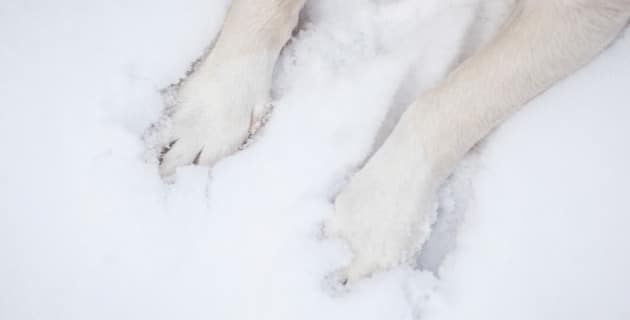
by California Casualty | Pets, Safety |
For many of us, winter weather means it’s time to put down that layer of salt. After all, you don’t want to hurt yourself or be liable if anyone slips on your sidewalk!
Ironically, in your effort to keep everyone safe, you might be endangering the very ones you want to protect. That’s because ice melt is dangerous for pets. And it’s not just the ice melt on your property. Ice melt that is universally used on roadways and walking paths is usually not pet-friendly and can cause serious harm and even death.
Here’s what you need to know to keep your pets safe this snowy season.
Know the chemicals.
Ice melt is made up of chemicals like sodium chloride (the same as table salt) and calcium salts (calcium carbonate, calcium magnesium acetate, and calcium chloride). Sometimes it also contains potassium chloride, magnesium chloride and/or urea (carbonyl diamide). These chemicals lower the freezing point for water, causing the ice to melt and turn to slush. In addition to having an effect on ice, they also cause damage to concrete, cement, soil, and water, as well as plants and animals.
That’s where your pet comes in. It may be tempting for your dog or cat to sniff around at ice melt because of its salty taste. Or they may walk on it and get it on their paws, and then lick it off. But even table salt is dangerous for them in large quantities.
If ingested, ice melt can cause anything from mild indigestion to severe vomiting, diarrhea and dehydration, and even death. Just 4 g/kg of sodium chloride can be deadly, according to the Pet Poison Helpline. According to Pet MD, ethylene glycol-based ice melts contain the same active ingredient as antifreeze. They are deadly if ingested. Calcium chloride also can cause mouth ulcerations and irritation. So, what do you need to look out for in your pet? An abnormally high body temperature, a racing heart, and rapid breathing are all signs of elevated blood sodium levels. Keep reading for more signs and symptoms.
Ice melt is also a skin irritant. It can cause irritation, dryness, and even burns on your fur babies’ paws or between their pads. If they scratch or rub their face, the ice melt can get in their eyes. If a small piece of salt makes its way in between your pet’s pads, it can be highly uncomfortable and have a chance of being swallowed.
If you’re thinking you can just check the package and make sure these ingredients are not listed, think again. Unfortunately, not all ice melt packages provide a full list of ingredients.
Are there any ice melts that are safe for pets?
You can buy ice melts that are labeled ‘safe for pets’, but even these are not completely safe, according to the Pet Poison Helpline. They are simply safer options. If ingested, they can still cause gastric distress. Also, while safe for dogs, ice melt with propylene glycol can be damaging to cats’ red blood cells, according to PetMD.
Products safe for pets usually are urea-based. They are some of the safest options for dogs and cats, but if you have goats or cows, beware. Urea can cause ammonia toxicosis in animals that have that type of digestive tract.
How to Prevent Exposure
An ounce of prevention is worth a pound of cure. Keeping your pet away from dangerous ice melts is your first defense.
-
- Avoid areas that are slushy or where it looks like ice melt has been applied.
- Don’t let pets sniff or eat road salt, ice melt, etc.
- Don’t let pets run and play in an area that looks like it has been treated with ice melt.
- Wipe your pet’s paws with a damp cloth to remove any ice melt as soon as you come in from outside. This way, your fur baby won’t accidentally ingest it when licking his/her paws.
- Store the ice melt package far out of reach of curious pets.
- If you want to protect your fur baby’s paws, consider paw wax or doggie booties.
- Instead of ice melt, try products intended to provide traction, such as sand, gravel, kitty litter, and wood ash.
Watch for these signs and symptoms.
Keep a close eye on your fur baby, If you notice him/her walking gingerly or licking his/her paws, there could be a problem. Also, look for these signs of possible exposure to ice melt:
-
- Skin irritation/burns
- Mouth ulcers
- Increased urination
- Excessive drooling
- Nausea/gastrointestinal upset/vomiting
- Body and muscle weakness
- Seizures
Call your veterinarian right away if you believe your pet has ingested ice melt and is exhibiting symptoms. The ASPCA Animal Poison Control Center also is available 24/7 to answer your questions. A consultation fee may apply.
Pet health insurance can help cover the costs if anything should happen to your fur baby. Make sure you are fully covered in event of an emergency.
This article is furnished by California Casualty, providing auto and home insurance to educators, law enforcement officers, firefighters, and nurses. Get a quote at 1.866.704.8614 or www.calcas.com.

by California Casualty | Auto Insurance Info |
You’ve done it a hundred times – sitting in a cold car, watching your breath while you’re waiting for the engine to warm up. It’s a necessary part of winter driving, right? Experts would disagree.
It used to be that cars needed to be warmed up before you could drive them in cold temperatures. But that’s no longer the case with today’s vehicles. Whether you’re an experienced or a new driver, here’s what you need to know.
Why today’s cars don’t need a lot of warm-up time
A car’s engine works by igniting a mixture of gasoline and air. That used to be the job of the carburetor. But carburetors didn’t work well in cold temperatures because they couldn’t get the right mix with denser cold air. If you didn’t warm them up, you ran the risk of stalling your car. Starting in the 1980s, manufacturers stopped using carburetors in favor of new technology.
Today’s vehicles use electronic fuel injectors that can detect cold weather and release extra gasoline for the right fuel-air mix.
Warming up your car is a waste of time, gas, and money.
It’s a given that you could be using your time more productively than waiting for your car to warm up. As you idle, you’re burning gas, which is essentially wasting money, too. You’re also increasing wear and tear on your car’s engine. Plus, you’re adding pollution to the air. According to a 2009 study, idling your car contributes to 1.6% of all U.S. greenhouse gas emissions. That’s nearly double the entire iron and steel manufacturing industry. States have begun to take notice and issued anti-idling fines beyond 3 minutes.
A one-minute warm-up
With your car’s onboard computer and fuel injection system, it takes just about one minute for your car to warm up. That’s regardless of the outside temperature. That doesn’t mean that the inside of your car will be warm, or that the windows will be defrosted, but it does mean that the oil has traveled from the bottom of your engine to the top.
7 Steps to quickly heat up your car
Follow these steps to quickly heat up your car this winter.
1. Turn on your ignition without starting the engine. After about 5 seconds, you should hear the fuel pump priming the engine. Then start the car.
2. Don’t turn on the heat right away. The air being pumped out from the heater core will still be cold. That air will keep the engine from getting hot quickly.
3. Also make sure you are not running the radio, your seat warmers or defroster initially as these put a strain on the electric system.
4. Idle your vehicle for about 30 seconds (or a minute if your car is older). You can go a little longer if your car is covered in snow or ice. This will allow your vehicle to produce warm air.
5. You do want to give yourself time to warm up that has nothing to do with the engine. It’s all about your visibility and your comfort. You want to be able to see while you are driving and you want to be comfortable enough so you can concentrate on the road. Turn on the defroster to help clear the windows. Wait until you can drive safely; don’t try to drive with a small portion of cleared window.
6. Cars will warm up faster if you are driving than if you are idling. Normal driving for 5-10 minutes should do the trick.
7. Once you’re driving, point the warm air at your chest. That will warm you as quickly as possible. Then point the heat at your feet. As heat rises, the whole car will stay warm.
Tips for the extreme cold
In some places in the U.S., such as the upper Midwest, temperatures can dip well below zero and stay there. Consider these additional steps to help your car weather the cold.
-
- Once regular oil gets below 20 degrees Fahrenheit, it becomes thick. Use synthetic oil which holds its consistency.
- Battery heating pads and thermal wraps can keep your battery warm. A cold battery trying to hold a charge in frigid temperatures can harm your alternator.
- Oil heaters for the dipstick or magnetic heaters for the oil pan can help. There also are coolant heaters for antifreeze.
- Engine block heaters attach to your car and plug into an electric outlet. You can install a permanent heater, too.
Protect your car with auto insurance for peace of mind this winter and all year round.
This article is furnished by California Casualty, providing auto and home insurance to educators, law enforcement officers, firefighters, and nurses. Get a quote at 1.866.704.8614 or www.calcas.com.
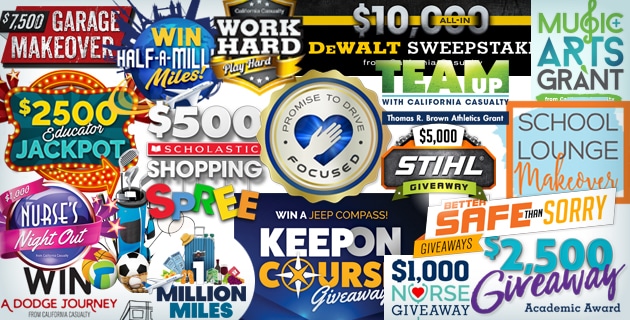
by California Casualty | In Your Community |
What began as a School Lounge Makeover has transitioned into a multitude of community giveback programs that have made a difference to you (and us!) over the last ten-plus years. We call them California Casualty Community Impact Programs or CCCI for short. They are the “brand energizers” or giveaways, grants, and sponsorships created to support your community endeavors.
The following is a brief list of different programs that we have offered throughout recent years. Please tell us what programs you would like to see again, and/or any new ideas that you would like to see introduced by commenting below.
SCHOOL LOUNGE MAKEOVER – CLOSED
Educators work hard and deserve a pleasing, well-functioning place to rejuvenate, plan, meet or have a meal. The School Lounge Makeover was piloted at Colfax Elementary School in Denver in 2010, and formally launched nationwide in 2011. The yearlong contest awarded four winning schools $7500 (one randomly drawn winner per quarter) to transform their school lounges with assistance from local designers, painters and others.
THOMAS R. BROWN ATHLETICS GRANT PROGRAM – CURRENT
The California Casualty Thomas R. Brown Athletics Grant Program was created to financially aid public middle and high school athletic programs impacted by reduced budgets. The program provides a grant of $1,000 for each public middle and high school awardee. Applications are received year-round. Applicants must be an active member of NEA or one of our participating administrator groups in the 44 states that California Casualty serves.
CALIFORNIA CASUALTY AWARD FOR TEACHING EXCELLENCE – CURRENT
The California Casualty Awards for Teaching Excellence recognize educators whose professional practice and advocacy for the profession are exemplary. The NEA Foundation and the National Education Association jointly present the awards with support from California Casualty, NEA Member Benefits, and Pearson Foundation. In addition to being honored at the Washington, D.C. gala, educators’ schools receive an award/gift from California Casualty. Nominations are made through state associations in the spring; the gala is held the following winter.
CALIFORNIA SCHOOL RECOGNITION PROGRAM – CURRENT
As Presenting Sponsor of the California School Recognition Program, California Casualty joins the California Department of Education (CDE) in celebrating the California educators that are exceeding expectations as they create safe, inclusive environments for learning. The California School Recognition Program recognizes these exceptional teachers, administrators, and classified employees through The California Teachers of the Year Gala,
The Classified Employees occasion, regional Gold Ribbon Recognition events across the state, and on-site Gold Ribbon Schools award presentations fulfilled by California Casualty Field Reps.
HELP YOUR CLASSROOM – CLOSED
Help Your Classroom was an opportunity for NEA members who request a quote from California Casualty to be entered into a random, monthly drawing for $200. Knowing staff frequently spend out of pocket to provide the necessary tools for learning for their students, the funds were provided via email as a credit for an online vendor so the recipient could purchase classroom supplies and equipment to be delivered to their school.
WORK HARD/PLAY HARD – CURRENT
A variety of public safety prizes have been given away under the theme of an annual “Work Hard, Play Hard” contest. We understand the demands of the job and the appreciation for opportunities to play just as hard. For this contest, firefighters, law enforcement, and EMTs are invited to simply enter to win – no strings attached. The odds of winning are based on the number of entries received. Prizes typically range in value from $7,500 to $10,000 – sometimes even more. To date, contest prizes include a SeaDoo personal watercraft; Harley Davidson 48; Polaris ATV (spring 2012); Bass Boat; DeWalt Tools, 5.11 Gear, and Liberty Safe; Garage Makeover, etc.
FIRE STATION MAKEOVER – CLOSED
Firefighter shifts are long and, when not out on call, firefighters work and live in the same physical space. A tight economy has delayed or canceled station upgrades. Similar to the School Lounge Makeover, this giveaway gave the winning entry a $15,000 makeover for one fire station room with assistance from local designers, painters, and others. The winning package included new kitchen and laundry appliances from Maytag, a fresh coat of paint inside and out from Sherwin-Williams, and a big-screen, closed-circuit TV system from FireRescueTV.
NURSE NIGHT OUT – CURRENT
In 2012, California Casualty originally coined the giveaway as a Nurses Night Out promotion to provide nurses the opportunity to blow off some steam – renting a limousine and hitting the town, hosting a party, or treating their co-workers to a fabulous meal at their favorite restaurant – in relief of the endless hours spent meeting the needs of patients and their families. The 2020 Nurses Night Out campaign honored these same frontline healthcare professionals as they battled COVID-19 – through incredibly long hours, heartbreaking care cases, and increased personal risk. It was then decided to change the tone and the look of the promotion to a message more appropriate for the times. The new look focuses more on the appreciation California Casualty and communities across the country – and around the world – have for the compassion, dedication, and personal sacrifice these Healthcare Heroes exemplify.
ACADEMIC AWARD – CLOSED
Over 90% of educators reach into their own pockets to provide instructional supplies, food, and personal care items for their students. California Casualty pitched in with the Academic Award program to help with the expense of classroom and student needs. The contest awarded multiple K-12 public school educators with a $2,500 Academic Award. The check was made payable to the school with an understanding that the funds will be designated for use by the winning administrator, classified employee, or teacher of that school.
NOMINATE A HERO – CLOSED
To honor the everyday heroes we serve, California Casualty invited people to share the stories of heroes they knew. The “Nominate a Hero” program asked community members to share how a particular nurse, firefighter, educator, or peace officer made a difference in their lives and communities. Candidates for the Nominate a Hero program are nominated online by their family members, friends, and coworkers—and sometimes by strangers touched by their actions. A monthly winner received a $250 gift card and their place in our Hall of Heroes. An annual winner was then selected from the 12 monthly winners and received a $10,000 cash prize.
MUSIC & ARTS GRANTS – CURRENT
Created to assist schools in bringing artistic programs into the classroom, the Music and Arts Grants program considers grant requests for public K-12 schools whose music and arts programs are in jeopardy or in great need of funding. Requests will also be considered for individual classrooms wishing to integrate music and/or arts projects within school curriculum.
IMPACT TEEN DRIVERS (ITD) WORKSHOPS – CURRENT
Teen reckless and distracted driving is an epidemic, yet 100% preventable. Impact Teen Drivers works with you and other influencers to deliver a simple, yet life-saving message to young drivers and their passengers: Focus on the road ahead and get to where you are going safely. Developed as a multi-faceted approach, this powerful program gives advocates the flexibility to get involved on their own terms— from direct outreach and education through association or school presentations to Train-the-Trainers and Parent-Teen Safe Driving Workshops.
ITD CREATE REAL IMPACT CONTEST – CURRENT
Students across the nation, aged 14-22, can win cash prizes for their best creative message against dangerous distracted driving. Utilizing peer-to-peer messages, Impact Teen Drivers and California Casualty encourage students to help spread the word that distracted driving, the number one killer of young drivers, can be reduced and prevented. The seasonal Create Real Impact contest (Spring and Fall) was initiated in 2009 to find proactive solutions to the deadly epidemic of inattentive teen driving.
PROMISE TO DRIVE FOCUSED – FORD FOCUS GIVEAWAY – CLOSED
Surrounded every day by children, educators know all too well how devastating the preventable death of a young person can be. As natural role models, educators’ actions are noticed by students and colleagues. That’s why California Casualty asked educators to “make the promise to drive focused,” complimenting the efforts of Impact Teen Drivers, a non-profit founded and supported by California Casualty to prevent distracted driving. Those who made a promise to drive focused were entered to win a new vehicle valued at $20,000.
KEEP ON COURSE – JEEP COMPASS GIVEAWAY – CLOSED
Following the success and engagement of the Promise to Drive Focused campaign, California Casualty once again asked educators to “Keep on Course,” and get home safely by avoiding distracted driving. Educators who made a promise to drive safely were entered to win a new Jeep Compass from California Casualty. The year-long Keep on Course campaign was dedicated to preventing needless tragedies from inattentive/distracted (multi-tasking behind the wheel) driving.
WHEREVER YOUR JOURNEY TAKES YOU…WE’LL BE THERE DODGE JOURNEY GIVEAWAY – CLOSED
Reminding educators of the importance of having the right insurance coverage for their stage in life, the “Wherever Your Journey Takes You, We’ll be There” sweepstakes showcased a comprehensive website of auto and home insurance information for the various stages of life, and offered educators the chance to win a new Dodge® Journey SUV.
WA GREEN RIBBON SCHOOLS – CURRENT
As the Green Ribbon Schools Local Sponsor, California Casualty provides funds to each Washington Green Ribbon School awardee to help with expenses traveling to the national honors ceremony in July, held in Washington, D.C., or apply the funds toward further improving their green programs.
Looking ahead – California Casualty will continue to introduce grants, programs, and giveaways each year. While many are coming to an end this time of year, replacements are introduced in Q1 each year. Future Connection newsletters will share details as they are available.
This article is furnished by California Casualty, providing auto and home insurance to educators, law enforcement officers, firefighters, and nurses. Get a quote at 1.866.704.8614 or www.calcas.com.

by California Casualty | Auto Insurance Info |
Winter driving presents its share of challenges, from icy road conditions to car batteries that strain due to the cold. If you live in a region where the temperatures dip down low, you could be sitting in a freezing car for hours if it breaks down.
Thankfully, some forethought and preparation can help. Make sure you’re fully prepared for whatever winter throws at you and stock up on these must-carry items for your emergency winter car kit this season.
#1: Ice scrapers, snow brushes, and a foldable shovel
It’s important to clear your whole car before you drive. Snow and ice can slide from your vehicle’s roof and obstruct your view while driving. It also could fly off and hit another car. Choose scrapers and brushes with long handles that allow you to reach the top of your vehicle. Stock several and the kids can help, too! Get a portable snow shovel too, one that folds so it takes up less space. Then use it to dig your car out as needed.
Tip: You can also use the shovel to add fresh snow or dirt around your tires to help them grip.
#2: A bag of sand or kitty litter
Your car may get stuck in the snow or be unable to move past an icy spot. Pour some sand or kitty litter over your tires and/or on the ground for extra grit to help with traction.
Tip: You can put your car’s floor mats down in front of your tires to get your car out of slippery situations. Watch the video from Firestone.
#3: Hazard triangles and LED flares
When you break down on the side of the road, you want to be seen—by other vehicles and by emergency personnel who can assist you. That’s the purpose of the hazard triangles and LED emergency flares. These are especially important when there is reduced visibility such as at night or during snowstorms.
Place the reflective hazard triangles behind your vehicle starting at 10 feet and going as far as 100 feet. Road flares have traditionally been used to mark sites for emergency responders. Rather than the traditional flares that light like a match and ignite, choose the modern version—a LED safety flare. They are designed to be waterproof, shatterproof, and crushproof and some are even magnetic and can stick right to your car.
Tip: To reduce the drain on your battery, use your car’s emergency flashers only if you hear vehicles approaching.
#4: A flashlight (and some extra batteries)
A flashlight can help you find things in the dark. It also can be used to signal passing cars. Choose an LED flashlight that offers plenty of light. If you can, pack several flashlights so that everyone in the family has one. Store batteries backward in the flashlight to prevent the light from accidentally switching on and burning out. Keep a spare set of batteries on hand just in case.
Tip: Pack some glow stick necklaces for the kids. They’re also great fun and an easy way to find everyone in the dark.
#5: Jumper cables and a battery charger
Low temperatures put an additional strain on your car’s battery. In fact, the freezing cold can turn a weak battery into a dead one overnight. If your car breaks down due to a dead battery, jumper cables can help. These cables allow you to charge your car’s battery from another car’s. You also may want to invest in a portable battery jump starter. These devices jump your battery without another car. They also can power your other devices such as cell phones or tablets.
Tip: Find out much battery life you have left with a free battery test at Firestone.
#6: A cell phone charger and portable power bank
Your cell phone is your connection to the world—and to help. Keep it as charged as possible by having a charger in your car. However, if your car doesn’t start, the car charger won’t do much good. Be sure to pack a portable battery or power bank.
Tip: If you’re stuck and your cell phone is losing power, change your outgoing message to your current location, time and date, and any other important details. That way, if your cell phone stops working, callers will get that message.
#7: Blankets and cold weather clothes
Keep a few blankets or sleeping bags in your trunk. If you want to save on room, choose pocket-size heat-reflective blankets. Then, stock some warm clothes for every member of the family: old sweatshirts, thick pants, warm socks, boots, mittens, and warm hats. Add some hand or feet warmers, which could provide much-needed warmth in an emergency.
Tip: Don’t run your car’s engine unless you are sure the exhaust pipe is free of snow. Snow can plug your vehicle’s exhaust system and cause deadly carbon monoxide gas to enter your vehicle.
#8: Snacks and water
If you’re spending any significant time in your car, you’ll want food and water. Keep water bottles and non-perishable snacks in your car through the winter. Consider these ideas: prepackaged trail mix or nuts/seeds, dried fruit, granola bars, chocolate, dry cereal, crackers, cookies, peanut butter (or other nut butters), rice cakes, pretzels. Choose kid-friendly snacks in case the kids are with you; you’ll enjoy them even if they’re not there.
Tip: For a more substantial snack, pack canned food that can be eaten cold and a can opener. Don’t forget the plastic utensils.
#9: Entertainment
Keep the kids busy with some games and activities. This will help keep them from feeling stressed and it will help pass the time. Pack a travel game bag. Include decks of cards, puzzles, coloring books and crayons or paper for older kids, and travel games. Sing songs, tell jokes, and keep the time as light-hearted as possible.
Tip: Make it a game. Take a poll on how long it will take to get home or what the tow truck driver will look like.
#10: First Aid Kit
A first aid kit is especially needed in winter because emergency response times may be longer due to icy or snowy conditions. You can buy one or make your own. Include bandages, gauze, adhesive tape, antibiotic ointment, scissors, saline solution for eye washing or cleaning wounds, aloe vera to treat minor burns, an antihistamine for allergic reactions, and anything else your family may need.
Tip: Add baby wipes, which will help if you or the kids have to go to the bathroom outdoors in nature. A garbage bag can also be a makeshift toilet if need be.
You can save some steps and buy emergency roadside safety kits that combine many of the items on this list.
Finally, should you have a winter-related accident or incident, know that your collision and comprehensive insurance will help protect you.
Safe travels.
This article is furnished by California Casualty, providing auto and home insurance to educators, law enforcement officers, firefighters, and nurses. Get a quote at 1.866.704.8614 or www.calcas.com.

by California Casualty | Auto Insurance Info |
We’ve all got that one person in our lives who absolutely lives for cars. Their knowledge can rival any Google search. And don’t even get them started about a certain body style or engine, or they’ll never stop. To them their car isn’t just a car; it’s their baby.
If you’ve got one of these folks on your gift list, you’re in luck! Whether it’s the latest tech toy or the unusual find, we’ve got the best gifts for all car enthusiasts below.
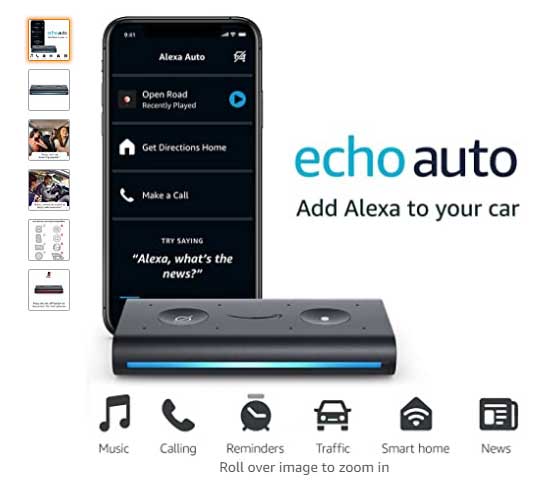
Hi-tech Gear
The car may be the centerpiece but these hi-tech additions can make a sweet ride even sweeter!
- Amazon Echo Auto puts Alexa right in your car. The device connects to the Alexa app on your phone and plays through your car’s speakers. Alexa can play music, make calls, find a nearby coffee shop, pay for gas, all at the command of your voice. It doesn’t work with all car models or smartphones, so check before you buy.
- NOCO’s Portable Battery Jump Starter Pack offers peace of mind if you ever need an extra charge. It’s also an LED flashlight and a portable power bank for USB devices. This booster is rated for gasoline engines up to 6 liters and diesel up to 3 liters.
- The Garmin Dash Cam Mini 2 alerts you if there’s an incident around your car and automatically records it. It provides video if you’re ever in an accident. This device is prohibited in some areas; make sure you’re aware of the local laws.
- The Car Cushion with Massage and Heat from Sharper Image offers comfort and warmth for those long, cold winter drives—and even the short ones!
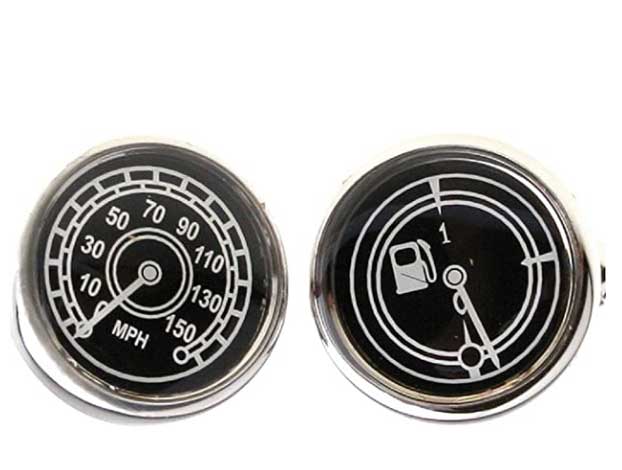
Car Inspired Fashion
These trendsetters are a must for car lovers when they aren’t behind the wheel.
- Puma has a line of motorsport sneakers that celebrate such carmakers as Porsche, BMW, and Ferrari. With logos and team colors, these kicks are perfect for life in the fast lane. Pair them with Heel Tread socks, inspired by classic car brands.
- Driving gloves are not only a stylish accessory. They give you a firmer grip on the wheel and they keep the wheel from getting dirty or sticky.
- From t-shirts with classic Corvettes to funny ones that proclaim “still plays with cars,” Zazzle has some great options.
- Speedometer and fuel gauge cufflinks are the perfect accessories for any dress-up occasion.
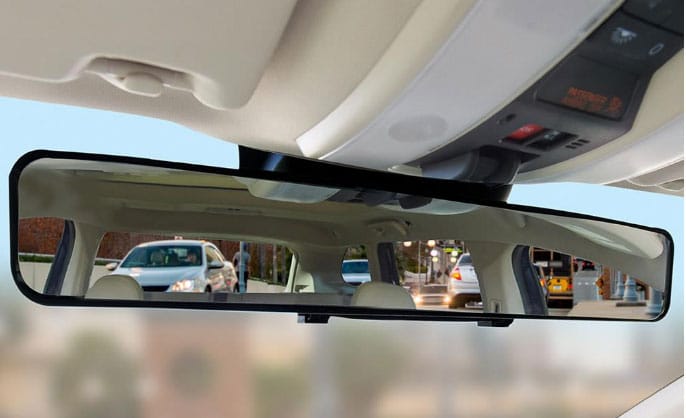
Practical – and Fun
Check out these fun and useful ideas for the car lover in your life.
- Etsy has some wonderful presents for car lovers. If you’re looking to open a little bubbly this holiday season, the spark plug bottle opener is the perfect gift. Or try these car coaster cup holders that keep those pesky places clean from dirt and debris. For the car-loving dad in your life, this key chain says it all.
- The No Blindspot Rearview Mirror was rated the best by the Hammacher Schlemmer Institute. It offers a 180-degree view with no distortion, and clips right over most existing rearview mirrors.
- The Gillette Heated Razor Bugatti Limited Edition pays homage to the iconic Bugatti. Plus, this razor heats up, delivering a shave that’s as luxurious as the car!
- Teachers, give a special gift by extending your NEA Member Benefits to eligible family members. NEA Member Benefits recently added siblings to the list of family members eligible to access the NEA Auto and Home Insurance Program provided by California Casualty. Parents, in-laws, adult children, and now siblings can take advantage of the special rates, deep discounts, and personalized service available through the NEA Auto and Home Insurance Program.
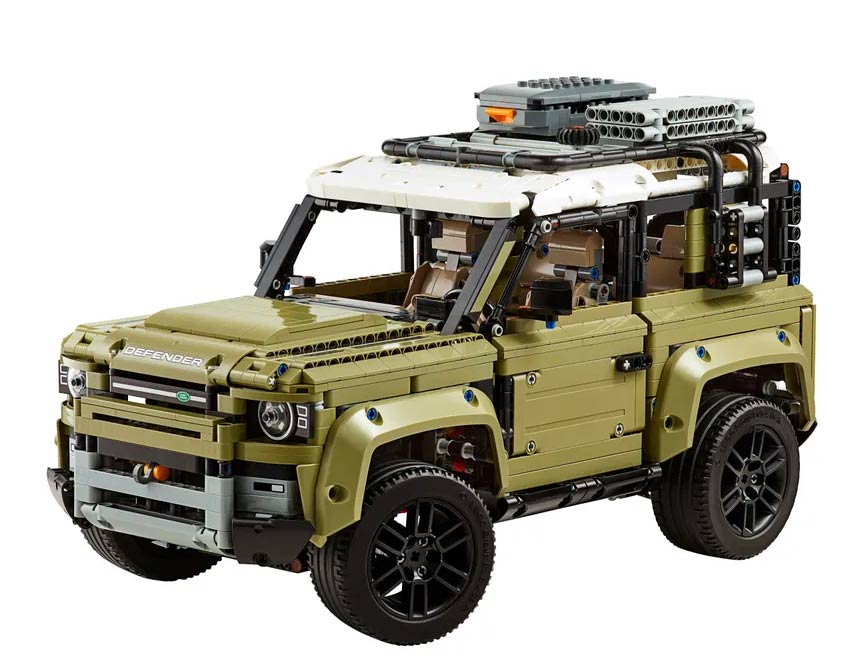
Just for Fun!
Put a smile on every car lover’s face this season with these uniquely fun gifts.
- LEGO® isn’t just for kids. The toymaker has an extensive line of car kits for adults. This includes the LEGO® Technic Lamborghini Sian FKP 37 and the James Bond™ Aston Martin DB5. Let the car lovers in your life build their dream car collection.
- For the gamer in your family, the Logitech G920 Racing Wheel offers a great “driving” experience. It realistically simulates the feel of your car and tires on every turn.
- When you can’t get enough of your car, a custom watercolor print is just the thing! You can also find beautiful car wall art on Fine Art America.
- For the ultimate gift, give your car lover a ride in a race car. Virgin Experience, Xtreme Experience , and others offer chances to drive tracks throughout the U.S. Also check Groupon for local listings of exotic car rides or rentals in your area.
Happy holidays from California Casualty!
This article is furnished by California Casualty, providing auto and home insurance to educators, law enforcement officers, firefighters, and nurses. Get a quote at 1.866.704.8614 or www.calcas.com.









